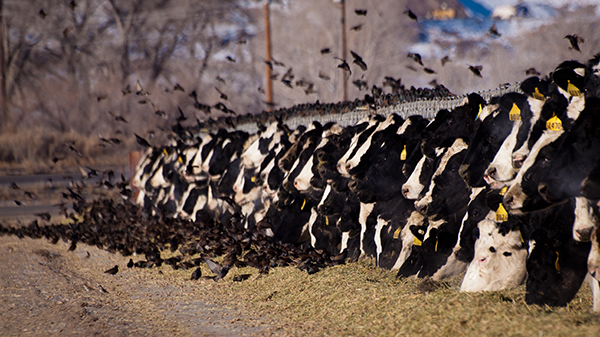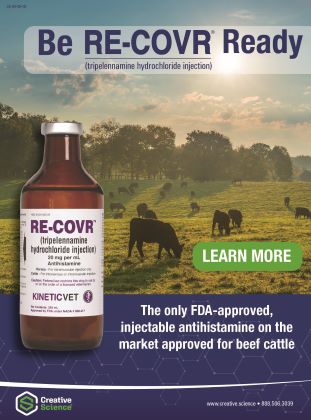Avian Influenza and Dairies: Risk, Prevention and What You Need to Know

By Jaclyn Krymowski for American Dairymen
Outbreaks of bird flu or highly pathogenic avian influenza (HPAI) on dairy farms have been in the public press and dairy press in recent months.. This worries not only consumers, but dairy producers trying to maintain a healthy, productive herd as well.
Birds have long been the bane of the dairy farmers. Not only can they carry dangerous diseases as we see today, but they are also destructive and flat-out nuisances. While it isn’t an easy battle, some steps can be taken to both prevent bird flu on your dairy and also keep the carriers out of your barn.
The Bird Flu and Dairy
HPAI transmission does not spread from cows being in close proximity to one another or from active shedding of the virus or exposure to other animals. Additionally, it has not put humans at a large risk from being around the cows.
Although the impact on dairies has not been a huge problem, the potential of it spreading to poultry and the implications of that is what has many on edge. When it comes to poultry flocks, if a single bird tests positive, the entire flock is depopulated. However, as of now there are no indications that such drastic measures will need to be taken on infected dairies by the U.S. Department of Agriculture.
“H5N1, like all influenza viruses, rapidly mutates to infect new hosts. However, H5N1 has several features that could increase its host range,” explains Jenna Guthmiller in a University of Colorado blog, Avian Flu Has Infected Dairy Cows in More Than a Dozen States – a Microbiologist Explains How the Virus Is Spreading.
In dairy cattle, she notes that H5N1 viruses are largely causing infections in the mammary glands rather than the respiratory tract.
“Recent studies have shown that the mammary tissue has receptors for H5N1, which could make this tissue susceptible to infection.”
The American Veterinary Medical Association (AVMA) says that typical symptoms of infected cows are reduced milk output, thick and discolored milk, and loss of appetite. The most common group of infected animals tends to be lactating cows though clinical symptoms are reported in less than 10% of cows in an entire herd.
Most affected animals reportedly recover with supportive treatment, and the mortality/culling rate has been low, at 2% or less. There has been no evidence that cattle are receiving the H5N1 from wild birds, but the possibility was not ruled out at the time of the investigation.
Although it seems cows show some signs of being infected with H5N1, they are essentially carriers for it and could have the biggest impact if they come in contact with animals more susceptible. This is still a concern and needs addressed so cows aren’t being transported or potentially impacting other species.
Human and Animal Health
While the impact on cowherds themselves is relatively minimal, there are legitimate human health concerns.
“Pasteurized milk appears to be safe, however,” write Jon Cohen and Martin Enserink in their Science article, Scientists call new measures to control bird flu in cows ‘a drop in the bucket,’ “…tests all came back negative. The U.S. Food and Drug Administration (FDA) has tested 297 samples of milk and milk products such as cottage cheese and sour cream from 38 states. Samples that tested positive for the virus with PCR (polymerase chain reaction)were then injected into embryonated chicken eggs to see whether any virus could be grown from it, Donald Prater, acting director of the Center for Food Safety and Applied Nutrition said on a 1 May call. None yielded live virus.”
According to AVMA: “A variety of retail dairy samples from multiple states have been tested for the virus, including pasteurized milk; pasteurized milk-based products, such as butter, ice cream, and various cheeses; and aged raw milk cheese. Although fragments of the H5N1 virus have been found in some samples, additional tests have shown the absence of live, infectious virus in those samples. Overall, the results indicate that pasteurization is effective in inactivating the virus, and reaffirm the FDA’s assessment that pasteurized milk is safe for human consumption.”
The FDA issued a recommendation that any state that permits raw milk sales should stop the sale of milk if it may contain viable H5N1.
“In early December, all raw whole milk and cream from a California dairy was recalled following detection of the virus in multiple samples from retail stores and dairy storage and bottling sites,”continues AVMA. “While no illnesses were reported, the finding is a good reminder of the risks of foodborne disease inherent to unpasteurized milk and milk products.”
Concerns have arisen because of bird flu when it comes to exporting and importing. Canada started requiring a test for H5N1 in all lactating cows. In addition, Colombia has restricted beef imports from states affected by the outbreak, although no H5N1 cases have been reported in beef cattle as noted by Cohen and Enserink.
Prevention and Surveillance
Partnering with state veterinarians, the Department of Agriculture announced nationwide milk testing per the December 2024 Federal Order and the National Milk Testing Strategy (NMTS).
According to the Animal and Plant Health Inspection Service’s official page: “The strategy is designed to increase our understanding of the virus’ spread in the United States; support the rapid implementation of enhanced biosecurity measures to decrease the risk of transmission to other livestock; and inform critical efforts to protect farmworkers to help lower the risk of exposure.”
The NMTS includes a multifactorial roadmap that includes dairy processing plant silo monitoring, state-specific surveillance, ongoing testing for case investigation and response, and mandatory testing for the interstate movement of lactating dairy cattle. These testing and surveillance measures are tailored to each state’s dairy industry and evolving HPAI status.
And of course, veterinarians and the Department of Agriculture are both promoting strong biosecurity protocols on the farm level.
Now is the time to establish a form of bird deterrence on your dairy if you don’t already have one in place. Summer is likely the best time to do this when there will be fewer birds taking refuge in barns than in the cooler months. Once a group establishes a place as their nightly roost, it can be much more difficult to keep them out.
Physically barriers to keep birds off the rafters can be beneficial, but they are by no means foolproof. Keeping doors and windows secured, especially at dusk when flocks come in to roost, is another small but helpful step. Some operations have found luck with electronic predator calls.
There are many different deterrent options out there with lots of opinions and anecdotes for each. Unfortunately, controlling wild birds is a complex issue that also includes keeping any state and federal regulations of protected species in mind.
Some main risk factors for the spread of bird flu range from shared equipment to shared personnel working on multiple dairy farms. Strong biosecurity that includes strict washing and clean clothing protocols are best practices.
“The outbreak could also put other countries at risk. U.S. dairy cows are trucked across the border to Canada and Mexico, but also flown to other countries,” write Cohen and Enserink. “Saudi Arabia imported 3,650 heifers—young female cows—in January alone, according to USDA data. The United Kingdom issued a reassuring statement on 19 April, noting that the country does not import live cattle from the U.S. and assess the risk as ‘very low.’”
Bird flu can still have an impact on the dairy industry even though it does not do near the destruction it could in poultry or birds.
While preventative methods can greatly help the spread of disease in the facilities and reduce the potential cases, they will not eliminate it. Having preventative measures and biosecurity protocols on the farm can also provide an additional layer of protection from disease and the spreading through the herd.
To learn more and see real-time updated about the status of HPAI and how testing impacts regulations in your state, be sure to visit aphis.usda.gov.
SOURCES
https://www.science.org/content/article/bird-flu-may-be-spreading-cows-milking-and-herd-transport
https://news.cuanschutz.edu/news-stories/avian-flu-has-infected-dairy-cows-in-more-than-a-dozen-states-a-microbiologist-explains-how-the-virus-is-spreading GUTHMILLER
https://www.avma.org/resources-tools/animal-health-and-welfare/animal-health/avian-influenza/avian-influenza-virus-type-h5n1-us-dairy-cattle
https://www.cidrap.umn.edu/avian-influenza-bird-flu/usda-reports-reveal-biosecurity-risks-h5n1-affected-dairy-farms SCHNIRRING
https://www.science.org/content/article/scientists-call-new-measures-control-bird-flu-cows-drop-bucket COHEN
https://www.agproud.com/articles/59493-top-10-tips-for-managing-pest-birds-on-dairy-farms
https://cdqap.org/wild-bird-deterrence/




